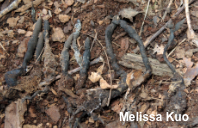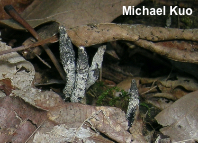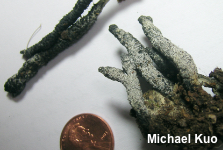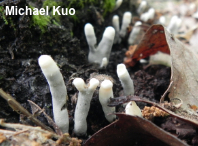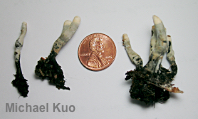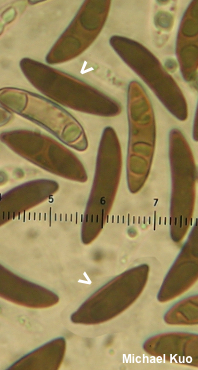| Major Groups > Clubs & Corals > Xylaria > Xylaria cornu-damae |

|
Xylaria cornu-damae [ Ascomycota > Sordariomycetes > Xylariales > Xylariaceae > Xylaria . . . ] by Michael Kuo Rarely (if ever) treated in field guides, Xylaria cornu-damae is not that uncommon, especially in the Midwest and the northeastern United States, where it is found on the decaying wood of hardwoods, or growing terrestrially in the vicinity of hardwood stumps. It is a small species with a typical Xylaria fruiting body: a black, pimply-looking cylinder. It is usually a little larger than Xylaria longiana, but substantially smaller than Xylaria cubensis or Xylaria polymorpha. Its anamorphic stage features a dusty whitish covering, like that of many Xylaria anamorphs, but in Xylaria cornu-damae the whitish coating hangs around a little longer and is often still present in fragments on mature, teleomorphic fruiting bodies. Ultimately, however, microscopic examination is probably required for successful identification of Xylaria cornu-damae; its spores are fairly large (on the Xylaria-spore scale) and feature a germ slit that extends only about half the spore's length. Description: Ecology: Saprobic on the rotting deadwood of hardwoods, or appearing terrestrial in the vicinity of hardwood stumps; late spring through fall; widely distributed in United States, but more common in the Midwest and northeastern states. The illustrated and described collections are from Illinois. Immature Fruiting Body (anamorph): Up to 40 mm long; cylindric; occasionally branched; surface powdery, dull gray to white—or gray overall with a white apex; interior flesh tough and white. Mature Fruiting Body (teleomorph): 30–60 mm long; 2–5 mm thick; more or less cylindric, with a pointy apex; only rarely branched; base gray to black; surface black and pimply, often with whitish remnants of the powdery coating of the anamorphic stage; sometimes with an underground "taproot" extending up to 60 mm below the surface of the substrate; interior flesh white and tough; perithecia in mature fruiting bodies more or less spherical, just below the surface. Odor: Not distinctive. Microscopic Features: Spores 17–25 x 4–6 µm; fusiform; smooth; dark brown in water; with a thin, pale germ slit that extends roughly half the spore's length. Asci 8-spored. REFERENCES: (Schweinitz, 1832) Berkeley, 1873. (Rogers, 1984; Rogers, 1986; Rogers, Miller & Vasilyeva, 2008, 2008.) Herb. Kuo 05171102, 07081105, 08251908. This site contains no information about the edibility or toxicity of mushrooms. |
© MushroomExpert.Com |
|
Cite this page as: Kuo, M. (2019, November). Xylaria cornu-damae. Retrieved from the MushroomExpert.Com Web site: http://www.mushroomexpert.com/xylaria_cornu-damae.html |
